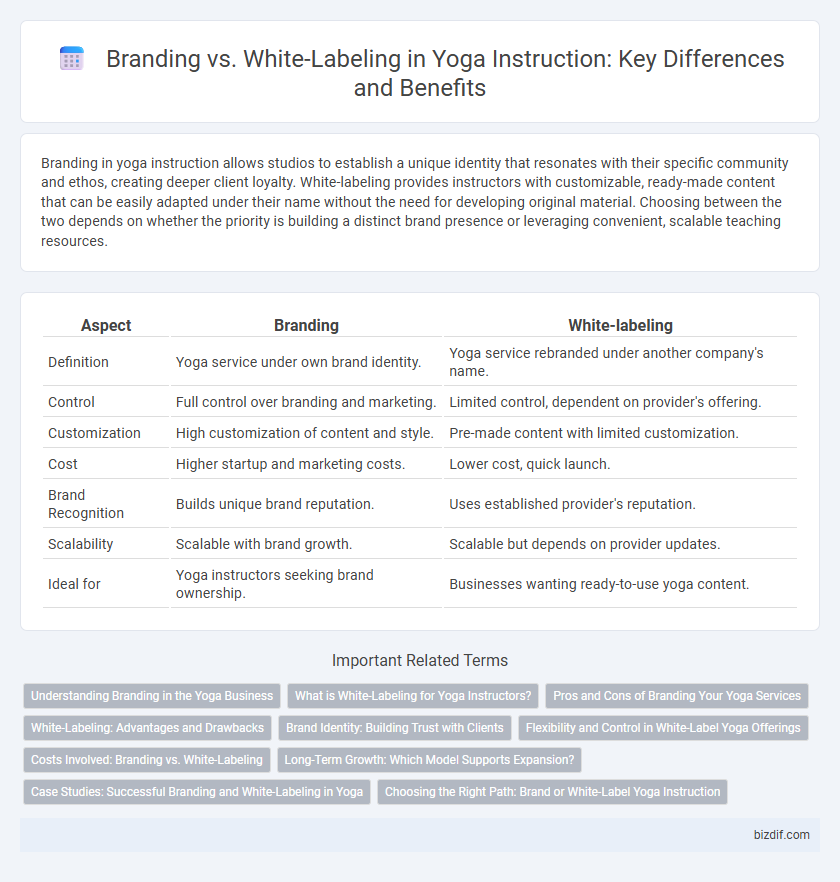Branding in yoga instruction allows studios to establish a unique identity that resonates with their specific community and ethos, creating deeper client loyalty. White-labeling provides instructors with customizable, ready-made content that can be easily adapted under their name without the need for developing original material. Choosing between the two depends on whether the priority is building a distinct brand presence or leveraging convenient, scalable teaching resources.
Table of Comparison
| Aspect | Branding | White-labeling |
|---|---|---|
| Definition | Yoga service under own brand identity. | Yoga service rebranded under another company's name. |
| Control | Full control over branding and marketing. | Limited control, dependent on provider's offering. |
| Customization | High customization of content and style. | Pre-made content with limited customization. |
| Cost | Higher startup and marketing costs. | Lower cost, quick launch. |
| Brand Recognition | Builds unique brand reputation. | Uses established provider's reputation. |
| Scalability | Scalable with brand growth. | Scalable but depends on provider updates. |
| Ideal for | Yoga instructors seeking brand ownership. | Businesses wanting ready-to-use yoga content. |
Understanding Branding in the Yoga Business
Understanding branding in the yoga business involves creating a unique identity that resonates with a specific target audience, emphasizing core values, mission, and the overall experience offered. Effective yoga branding incorporates consistent visual elements, messaging, and customer engagement strategies that differentiate the studio from competitors and build customer loyalty. A strong brand presence enhances credibility, fosters emotional connections, and drives long-term growth within the competitive wellness market.
What is White-Labeling for Yoga Instructors?
White-labeling for yoga instructors involves purchasing yoga programs, videos, or digital content from a provider and rebranding it as their own without developing original material. This approach enables instructors to offer professionally created yoga classes quickly while maintaining a consistent brand identity. White-label solutions allow yoga teachers to expand their offerings, save time on content creation, and deliver high-quality instruction under their personalized brand.
Pros and Cons of Branding Your Yoga Services
Branding your yoga services builds a unique identity that fosters customer loyalty and allows premium pricing based on perceived value. Establishing a strong brand presence differentiates your offerings in a competitive market but requires significant investment in marketing and consistent quality to maintain reputation. Limited scalability and higher initial costs can be drawbacks compared to white-labeling, which offers faster market entry with established products.
White-Labeling: Advantages and Drawbacks
White-labeling in yoga instruction enables studios to offer branded online classes or apps developed by third-party experts, fostering rapid market entry and reducing content creation costs. This approach preserves time and resources while allowing customization to align with studio identity, yet it may limit control over content updates and quality assurance. Dependency on external providers carries risks of inconsistent branding and potential restrictions in differentiating the service from competitors.
Brand Identity: Building Trust with Clients
Brand identity in yoga instruction plays a crucial role in building trust with clients by conveying authenticity, values, and a unique teaching approach. Branding helps yoga studios establish a recognizable presence and emotional connection, fostering loyalty and word-of-mouth referrals. White-labeling may offer scalability but often lacks the personal touch and distinctiveness essential for long-term client trust and engagement.
Flexibility and Control in White-Label Yoga Offerings
White-label yoga offerings provide instructors with greater flexibility to customize class content, branding, and marketing strategies, enabling a personalized experience that aligns closely with their unique teaching style. Unlike traditional branded platforms, white-label solutions grant full control over client interactions, pricing structures, and platform features, empowering instructors to build a distinct identity within the competitive yoga market. This control fosters stronger client loyalty and allows for scalable growth tailored to individual business goals.
Costs Involved: Branding vs. White-Labeling
Branding in yoga instruction typically involves higher upfront costs due to logo design, personalized marketing, and proprietary content creation. White-labeling reduces expenses by allowing instructors to use pre-made programs and materials under their own name, minimizing development and advertising investments. Choosing between the two depends on budget constraints and the desire for unique brand identity versus cost-efficiency.
Long-Term Growth: Which Model Supports Expansion?
Branding in yoga instruction builds a unique identity that fosters client loyalty and sustainable long-term growth through consistent messaging and personal connection. White-labeling enables rapid market entry with customizable programs but may limit brand recognition and control over customer perception. For expansion, branded yoga businesses gain stronger competitive advantage by cultivating trust and differentiated value over time.
Case Studies: Successful Branding and White-Labeling in Yoga
Case studies of successful branding in yoga highlight companies like Lululemon, which built a strong identity through unique apparel and community-driven marketing, enhancing customer loyalty and premium positioning. In contrast, white-label yoga platforms such as Glo enable studios to offer branded classes under their own name without extensive infrastructure, facilitating rapid market entry and diversified revenue streams. These models demonstrate distinct strategic benefits: branding emphasizes long-term equity and customer engagement, while white-labeling prioritizes scalability and operational efficiency.
Choosing the Right Path: Brand or White-Label Yoga Instruction
Choosing between branding and white-label yoga instruction hinges on control and market identity; branded yoga programs allow instructors to build unique reputations and direct audience engagement, while white-label options offer scalable solutions with faster market entry under an established platform. Brand-driven instructors benefit from personalized marketing strategies, customer loyalty, and long-term asset creation, whereas white-labeling provides streamlined content delivery without the overhead of brand management. Evaluating goals, resources, and target audience alignment guides yoga professionals to select the approach that maximizes both impact and growth potential.
Branding vs White-labeling Infographic

 bizdif.com
bizdif.com